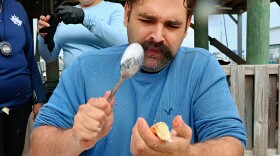MADELEINE BRAND, host:
This is DAY TO DAY. I'm Madeleine Brand.
One of life's great frustrations: cutting a mango. Do you cut it in half, trying to get close, but not too close to the pit? Do you peel it and then hack away at the flesh? Thankfully, and for me not a moment too soon, a new tool has arrived to help. It's called the Mango Splitter. It's from OXO, and Kevin Walzak invented it. His day job? He's a pastor in Syracuse, New York, and he joins me now.
Welcome to the program.
Reverend KEVIN WALZAK (Inventor, Mango Splitter): How are you, Madeleine?
BRAND: Fine, thank you. Well, tell me about this Mango Splitter. How does it work?
Rev. WALZAK: When you get the mango--Right?--just point the nose--you know what I mean by the nose?
BRAND: I know what you mean by the nose.
Rev. WALZAK: Point the nose away from you. Put this thing on the top, steady it a little bit, and once you get it started, don't be afraid to go for it. And that seed will just come right through the hole that you have on the Mango Splitter. And you'll be saying, `Wow!'
BRAND: So you split it in half?
Rev. WALZAK: Exactly. And once you press down and the seed is out, you have two halves that are just ready for you to do whatever you want with. It just is so smooth and easy that I think anytime I have done it or shown someone who's eaten mangoes, they just say, `Boy, I can't wait to get one of those.'
BRAND: That doesn't sound like a sales pitch.
(Soundbite of laughter)
Rev. WALZAK: It is.
BRAND: A little bit. How did you come up with this?
Rev. WALZAK: Well, about two years ago, my sister gave me a piece of mango on Thanksgiving Day, and she went into telling me how good it was for me and so forth. And so when we came back after Thanksgiving, I went to the store and bought a few mangoes. I pulled out my knife and found that mangoes are extremely difficult to cut. And when you do get them cut, because of the seed, you often get a lot of waste that is left on the seed, and you spend a whole lot of time really trying to get at the fruit itself. And as I was eating it I thought to myself, `Boy, wouldn't it be nice to see if someone has made something to get this seed out?' And in the process I found four ways to eat mangoes, but none of them actually had a tool or an implement to actually get this seed out. They actually eat more mangoes in the world than they do apples.
BRAND: So your invention could really change the world, in a way.
Rev. WALZAK: Well, I think that it has potential. I figure there are three or four billion people who eat mangoes. It's just a huge fruit. And...
BRAND: Well, curious, then...
Rev. WALZAK: Yeah.
BRAND: ...that it's taken so long to come up with a tool to cut the mango.
Rev. WALZAK: Yeah, you know, and that was part of the process. I was looking on the Internet for a long time because I figured that someone had to have come up with this type of an idea. And no one did, so I just began to think about it, and I got a picture in my mind of what it could look like and how it might work and began to measure the different seeds of mangoes to see their sizes. And then I made a drawing of what I thought might be able to work and located a gentlemen who from time to time has built prototypes for different companies. After a week or so, he came back with something. And the first time that I did it, it actually worked. And I just said, `This is awesome.'
BRAND: Would it work on an avocado? Just curious.
Rev. WALZAK: No, I don't think an avocado. I have used it on peaches. I've used it on apples. I use it on pears. But it takes a little bit more of the flesh away on those fruits than on a mango.
BRAND: Kevin Walzak is a pastor in Syracuse, New York, and the inventor of the Mango Splitter.
Thank you again.
Rev. WALZAK: Have a great day.
BRAND: DAY TO DAY returns in a moment. I'm Madeleine Brand. Transcript provided by NPR, Copyright NPR.








